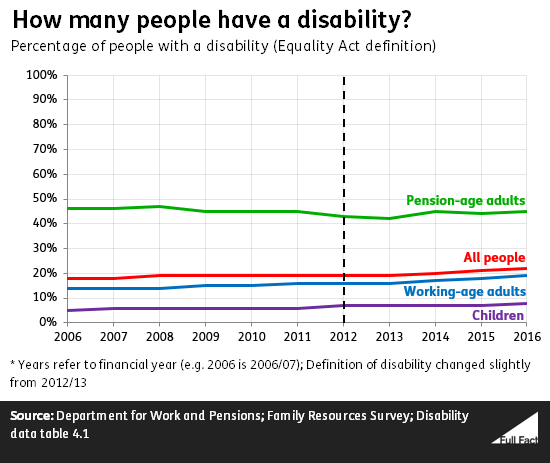What was claimed
Around 16% of the working age adult population has a disability.
Our verdict
This is broadly correct but slightly too low. An estimated 19% of working age adults have a disability, using the Equality Act definition.
Around 16% of the working age adult population has a disability.
This is broadly correct but slightly too low. An estimated 19% of working age adults have a disability, using the Equality Act definition.
“Around 16% of the working age adult population has a disability.”
The Guardian, 24 April 2018
An estimated 19% of working-age adults in the UK have a disability, according to the latest data published by the Department for Work and Pensions (DWP).
A person is considered under law to have a disability if they have a long-standing illness, disability or impairment which causes difficulty with day-to-day activities.
There are other ways of defining disability, but the DWP collects statistics using the legal definition. They measure disability using a survey, and changed the questions slightly in 2012/13 to bring their measure of disability in line with the Equality Act 2010 definition.
The questionnaire changes were relatively minor and the DWP said there is no reason to expect they had a major effect on the data. Indeed from 2011/12 to 2012/13 the prevalence of disabilities was stable despite the questionnaire change.
Since 2012/13 the proportion of working-age adults with a disability has risen from 16% to 19%. The proportion of all people with a disability is 22%, which has also been slowly increasing.  Mobility is the most common impairment, affecting just over half of all disabled people.
Mobility is the most common impairment, affecting just over half of all disabled people.
Mental health impairments have become more common in the past two years, affecting 20% of disabled people in 2014/15, up to 24% in 2016/17. Among working-age adults with a disability, it is the second most common impairment.
Full Fact fights for good, reliable information in the media, online, and in politics.
Bad information ruins lives. It promotes hate, damages people’s health, and hurts democracy. You deserve better.